Ertach Kernow - Cornwall's north coast before the RNLI lifeboats
Newquay RNLI will be running a Newquay Lifeboat Awareness Week from 2nd August showing various videos online. Newquay Museum will be contributing with a video telling the story of the early Newquay lifeboats from 1860 to 1946.
The following is an overview early lifeboat stations on the North Cornish coast before the RNLI stations were established. These were very different times, but what remains constant throughout is the bravery and courage of men, and now women, willing to give up their time and risk their lives to save those of others.
Cornwall’s coast is a dangerous place where countless vessels have been lost. Saving lives from ships wrecked on or near the shore has always been hazardous, albeit perhaps not what many Cornish people first considered when a ship foundered long ago. Some earliest recorded wrecks were those mentioned in the Penheleg Manuscript from 1580 that includes depositions by several elderly men who witnessed wrecks. The first of these was in 1514 when one James Cock aged 90 at the time he gave his disposition told how he saw a Spanish ship lost at Polkemyas (Porthkidney Sands, St Ives)
The wrecking of HMS Snipe in 1801 was witnessed by Captain George William Manby who then invented the Manby Mortar, this fired a cannon ball with a rope attached to a wrecked ship helping those on the shore to rescue the crew. Cornishman Henry Trengrouse witnessed the sinking of HMS Anson in 1807 afterwards created rocket apparatus designed to do a similar job, but with advantage that this was lighter and could be fired from the ship. The Trengrouse design was improved by John Dennett and for many decades the Dennett Rocket system became popular before it too was superseded by the Boxer Rocket system.
Before lifeboats became part of the maritime rescue strategy around the coast of Britain there were the coastguard. Evolving from the days when they chased smugglers into a service that included rescue, they formed the backbone of many Cornish communities efforts of saving life at sea. Besides the mortar and rocket equipment they would also have used naval whalers, usually fitted for six or eight oarsmen. Often the communities would assist using six oared Cornish pilot gigs manned by local fishermen and sailors.
On 24th March 1824 as the Institution for the Preservation of Life from Shipwreck was established, soon having Royal attached to it after gaining the patronage of George IV. A new design of lifeboat was approved in 1828 and would continue in use until designs for self-righting lifeboats were adopted in 1858. The Duke of Northumberland became president of the institute in 1851 and was instrumental in making many changes including to its name when it became the Royal National Lifeboat Institution or as often known now the RNLI in 1854.
Gradually the RNLI would provide their own vessels for various ports and harbours around the Cornish coast. On the north Cornish coast these would be established at Newquay in 1860, Hayle in 1866, Port Isaac in 1869 as well as taking over independent stations at Bude in 1853, Padstow in 1856 and St Ives in 1861.
St Ives first lifeboat was operated by a local committee. In 1838 Charles Fox offered as part of a competition by the Royal Polytechnic of Cornwall three guineas for the best model, not less than 18 inches in length, of a lifeboat, which shall be judged most manageable in a storm. The winner was Francis Jennings Adams, a St Ives boatbuilder, with his design that was so well received that he was asked to build a full-sized vessel for St Ives. Completed in 1840 it went to the rescue of a Pool ship the Mary Ann a few months later. This lifeboat named ‘Hope’ was certainly in existence until at least 1852, when mention was made of her. Later discarded she was refurbished as a fishing boat by a local fisherman. Hope seems to have been out of commission by 1860 and in 1861 the RNLI took over by opening their own station.
Hayle was an important 19th century Cornish port, exporting mining minerals and production from the Harvey engineering and foundry works. Despite increased shipping it had no rescue service, given numerous shipwrecks. Widespread reports of heroic bravery during the foundering of the Looe brig Richard and Mary in 1811, by two local men and the incapacity of the St Ives lifeboat from 1840 to assist on many occasions still did not result in a lifeboat until 1866. This came about through the loss of local vessel Bessie in January 1866. The Penzance and St Ives lifeboats needed to be transported overland to affect the rescue of nine men, due to the prevailing winds and tides. The previous October the loss of the French brig Providence led to a rescue by the St Ives lifeboat. Once again safety issues and the loss of some of the brigs nine crew at last led to establishing a lifeboat station at Hayle later that year with a lifeboat house built in 1897.
Newquay’s first lifeboat arrived in 1861 to a great fanfare and excitement with virtually the whole population turning out. The longstanding coastguard had been operating for many years and had use of Dennett rocket equipment saving many lives. The men earned several silver medals for their gallant work. Named Joshua funds for the new lifeboat were provided from an anonymous lady who had also provided for a lifeboat at St Ives called Moses. A boathouse had been built where the vessel was housed, this still exists as one of the oldest RNLI lifeboat houses remaining. Sadly, the Joshua was not to last long being replaced in 1865 as she suffered from dry rot.
Padstow on the Camel estuary, the only major river on the north Cornish coast, has been a port for many centuries. A lifeboat was commissioned in 1827 by public subscription and named ‘Mariners Friend’ and initially kept at the quay. It was later moved to a house at Hawkers Cove under the control of the rather wordy ‘Padstow Harbour Association for the Preservation of Life and Property from Shipwreck’. This organisation also attempted to mitigate hazards through placing of buoys as well as organising apparatus such as the Manby Mortar and other equipment. Over the next few years there were numerous rescues, but by 1855 this lifeboat was condemned, and the RNLI were asked for a replacement. There was no doubt whatsoever that a lifeboat would be forthcoming based of the excellent record ‘Mariners Friend’ and in 1856 the RNLI station with its first Padstow lifeboat the Albert Edward was established.
Port Isaac’s coastal regions have steep cliffs and abnormal sea conditions that caused many shipwrecks In the days of sail even for fairly local vessels. The sloop Busy of Newquay which had already been sunk off Padstow in 1847, but repaired and reregistered was sunk again in 1859 on the way back with coal from Newport for Pentewan. Reports say, ‘By the praiseworthy exertions of the inhabitants, in their boats, and at a great risk of their lives, with the assistance of the coast-guard, after a length of time the crew were saved’. Incidentally Master of this vessel from 1852 to 1854 was my great great grandfather also his brother-in-law was part owner and Master from time to time. In 1869 the final lifeboat station on the north Cornish coast between Padstow and Bude was established at here.
Bude’s maritime coastline including around Morwenstow is made famous through the rescue work of the Reverend R S Hawker and is notorious for shipwrecks. 1842 saw the Caledonia homeward bound from Odessa wrecked off Sharpnose Point between Bude and Morwenstow, all the crew except one were drowned. Those whose bodies were recovered were buried in the churchyard by Reverend Hawker, the vessels figurehead acting as a memorial. In 1836 the attention of King William IV had been drawn to the situation at Bude following two shipwrecks. He ordered money to be given from Duchy of Cornwall funds to provide a lifeboat at Bude. By 1848 she was in poor repair and in 1853 was replaced by a RNLI vessel establishing the Bude station.
Many of the historic Cornish lifeboat stations now have smaller fast inshore lifeboats that are well suited to the requirements of today. Rather than vessels being wrecked that require their crew to be saved it is more often people pursuing leisure activities that need rescuing. Over the following months the work of lifeboat stations around the whole Cornish coast and individual wrecks will shared as part of Cornwall’s historic maritime heritage.
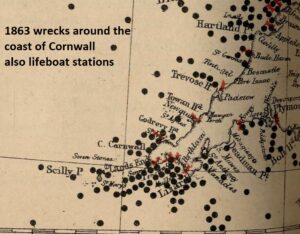
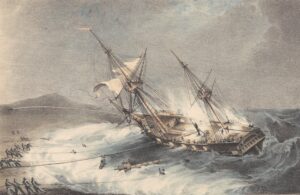
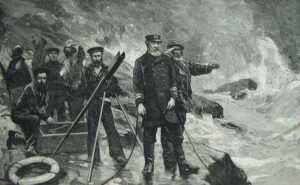
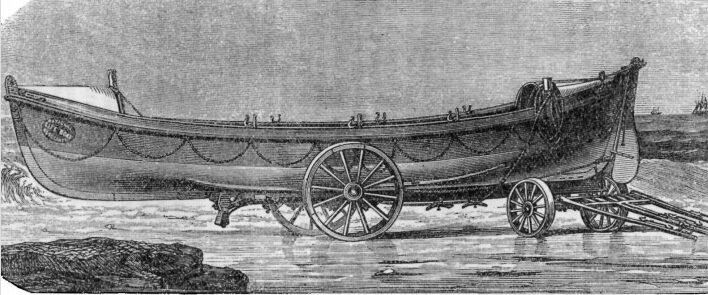
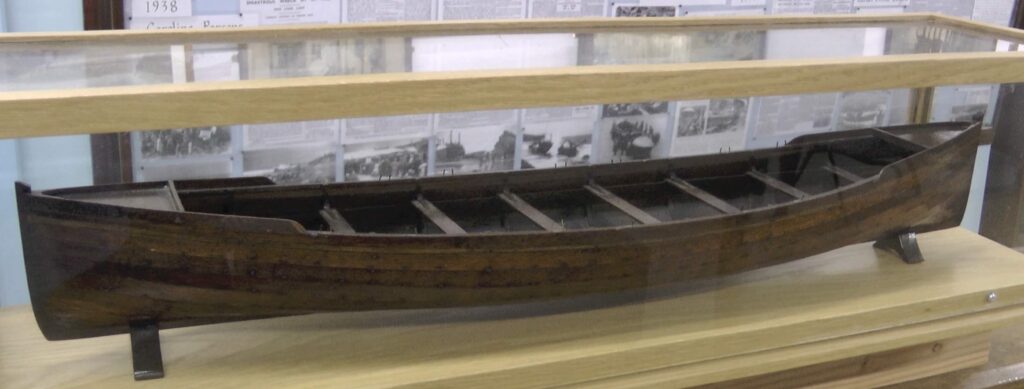
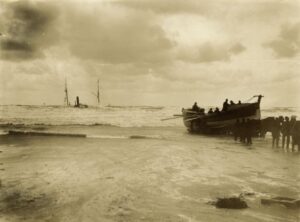
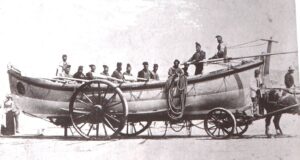
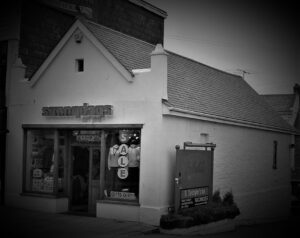
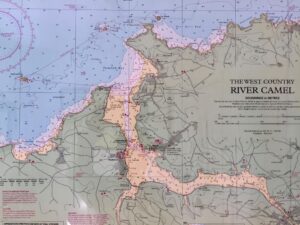
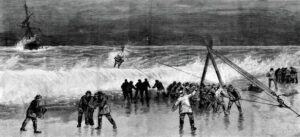
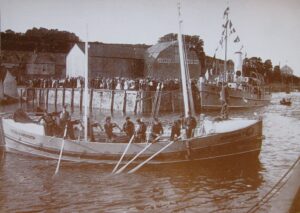
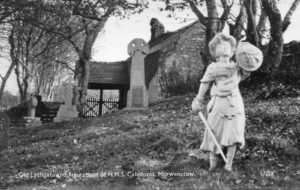
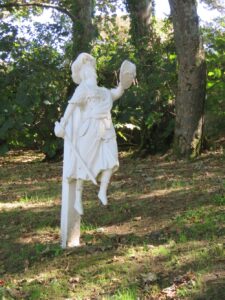
![[58] Voice - Ertach Kernow- 040821A For those in peril [L] Ertach Kernow- For those in peril - North Cornish coast before the RNLI lifeboats](https://www.cornwallheritage.com/wp-content/uploads/2021/08/58-Voice-Ertach-Kernow-040821A-For-those-in-peril-L-231x300.jpg)
![[58] Voice - Ertach Kernow- 040821B For those in peril [L] Ertach Kernow- For those in peril - North Cornish coast before the RNLI lifeboats](https://www.cornwallheritage.com/wp-content/uploads/2021/08/58-Voice-Ertach-Kernow-040821B-For-those-in-peril-L-231x300.jpg)